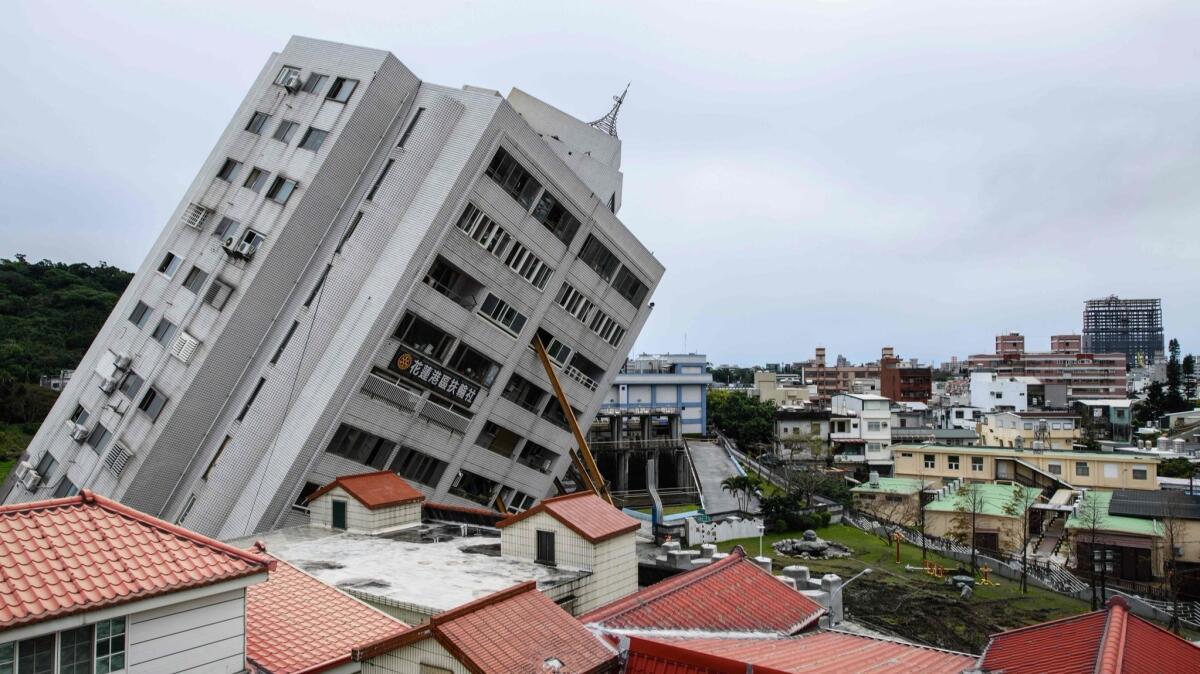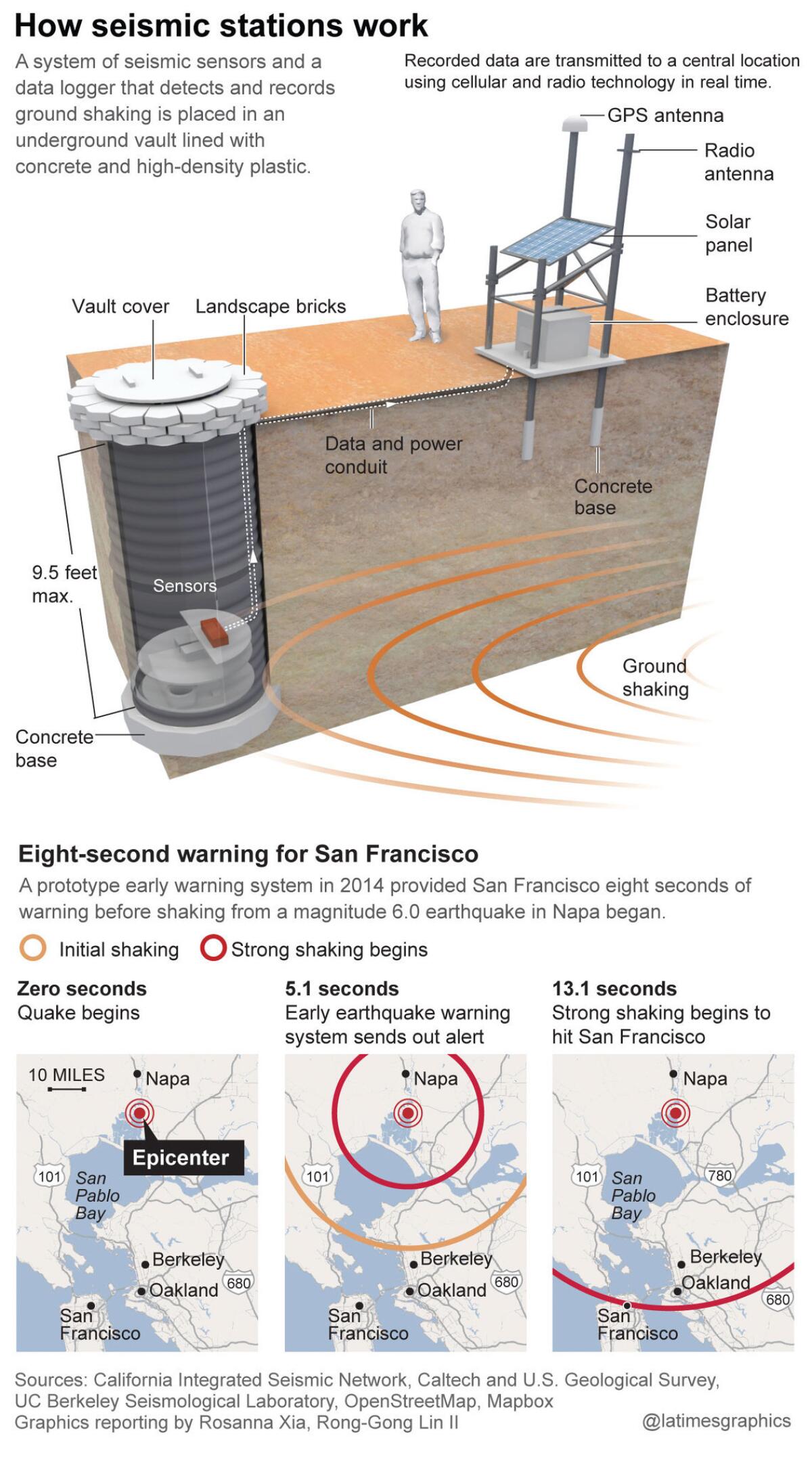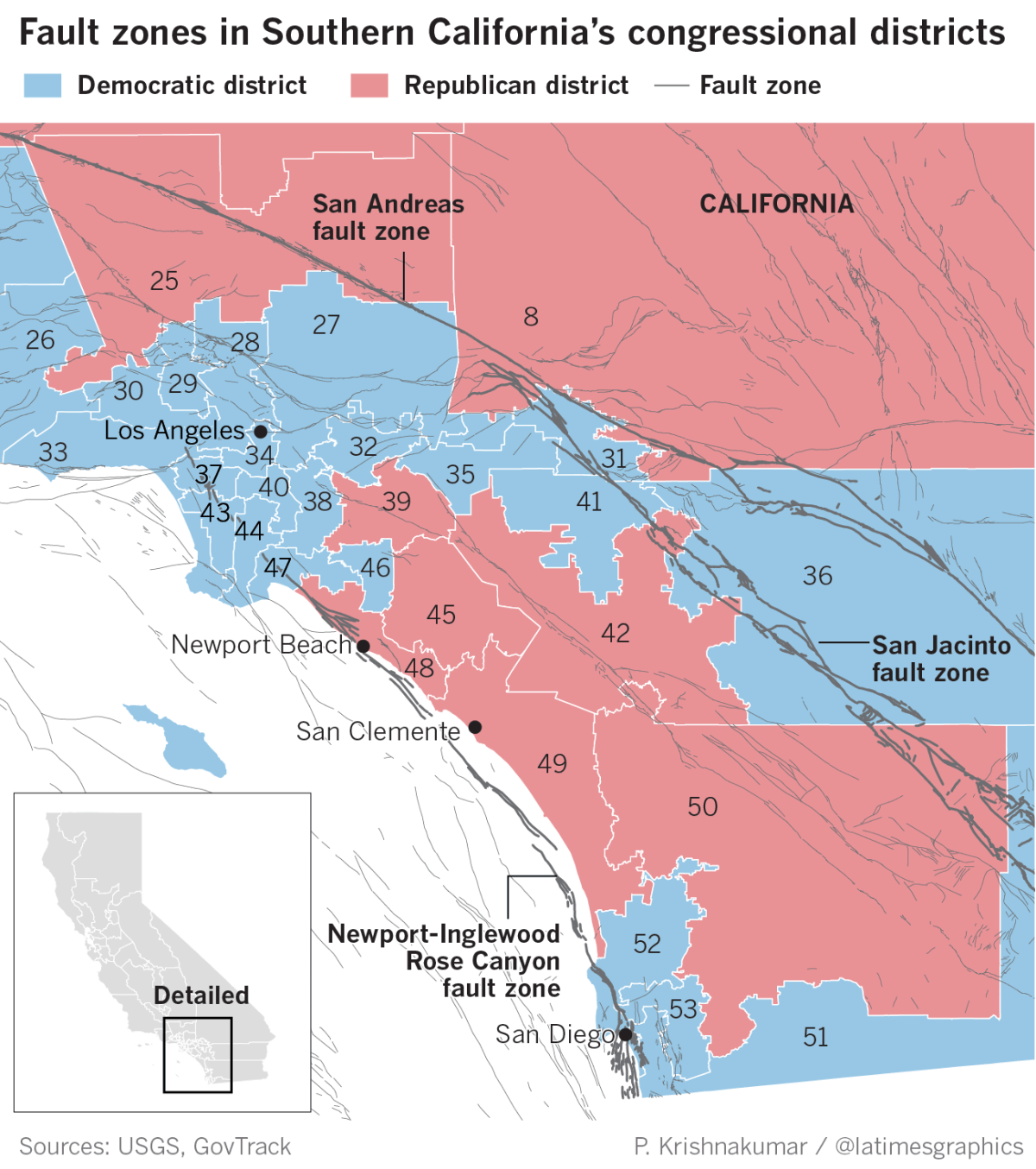Earthquake early warning system gets big funding boost in new budget

The earthquake early warning system under construction on the West Coast got a significant boost in the budget signed into law, defying an earlier proposal by President Trump to end federal funding of the program.
As part of the $1.3-trillion budget bill approved by Congress this week and signed by Trump on Friday, officials approved $22.9 million for the project.
That funding more than doubles how much the U.S. Geological Survey’s early warning system got in the previous year’s budget, $10.2 million.
“The significant funding provided in the bill will help ensure that the West Coast has a functioning earthquake early warning system in the near future,” Rep. Ken Calvert (R-Corona), chairman of a House subcommittee overseeing funding of the USGS, said in a statement.
“I will continue to be a champion for this life-saving technology that can have a significant impact when big earthquakes strike. Let’s take the steps we can to save Americans from preventable injuries during natural disasters,” Calvert said.
Lawmakers had faced a Friday deadline to approve a budget to fund the government for the fiscal year ending Sept. 30 and to avoid a government shutdown.
A spokesman for Calvert said the congressman visited USGS officials and agreed it was important to give the underfunded system a hefty boost.
“It was a big priority for him to get funding for the system to get it kickstarted,” said Calvert’s spokesman, Jason Gagnon. “Infrastructure, and getting the money in for the sensors, was key to advancing development of the system.”
Of the funding, $10 million is specifically set aside as a one-time investment for the physical buildout of the system. The remainder, $12.9 million, is for continued development of the early warning system.
Rep. Adam Schiff (D-Burbank), an early advocate of the early warning system, praised the vote and expressed gratitude to Calvert for his leadership in securing the funding.
“This system will not only help protect infrastructure and businesses, but also prevent injuries and save lives across California, Oregon and Washington,” Schiff said in a statement.
A spokesman for Los Angeles Mayor Eric Garcetti commended Congress for backing an increase in funding. “Mayor Garcetti is glad to see Congress did not follow the president’s direction to eliminate the important earthquake early warning program,” press secretary Alex Comisar said in a statement.

President Trump’s proposed budget would have killed the system before it launched. Officials were looking for “sensible and rational reductions and making hard choices to reach a balanced budget by 2027,” according to the administration’s proposal.
But the proposal to end funding raised bipartisan complaints up and down the West Coast.
A seismic early warning system for the West Coast has been under development for years by the USGS, the nation’s lead earthquake monitoring agency, but the project has remained short on funds.
It’s estimated that the system will cost at least $38.2 million to build for the West Coast and $16.1 million annually to operate and maintain.
The USGS has said it planned to begin issuing limited public alerts of the early warning system by the end of this year, as long as funding wasn’t cut. Southern California is one area where the network of seismic sensors is dense enough to begin early warnings.
For the system to go live all along the West Coast, more sensors still need to be installed in Washington, Oregon and sparsely populated areas of Northern California. More than 850 earthquake sensing stations are online, but about 800 more are needed. Too few sensors could mean, for instance, that Los Angeles would experience delays in warnings from an earthquake that starts in Monterey County and barrels south along the San Andreas fault.
Along the West Coast, facilities of all types are testing or planning to test the earthquake early warning system, including airports, oil refineries, pipelines, schools, universities, city halls and libraries.
Hospitals in California are testing audible notifications, broadcast from fire alarm equipment, so surgeons can remove scalpels and staff can shut off electric cauterizers to prevent fire. Condominium towers testing the warning system have been similarly rewired to give residents time to drop, cover and hold on before shaking arrives.
Hospitals are also devising procedures to automatically shut down coolant systems, which if broken during an earthquake could release toxic chemicals in a building.
Some office buildings have also been wired to automatically bring elevators to the closest floor, preventing people from being trapped after an earthquake. Internet-connected desk phones at a few offices at Santa Monica College have been turned into warning systems, sending out audio and visual alerts of an impending earthquake.
In Los Angeles County, rail operators for the Metropolitan Transportation Authority are now trained to stop when they hear word of an earthquake early warning from the control center. The San Francisco Bay Area Rapid Transit system is wired to automatically slow down trains when its computer system receives word of an incoming earthquake.
And the radio system at Universal Studios and Universal City’s fire station is programmed to alert crucial staff of expected shaking and allow firefighters to open garage doors before a possible power outage makes them inoperable.
The system works on a simple principle: The shaking from an earthquake travels at the speed of sound through rock — which is slower than the speed of today’s communications systems.
For example, it would take more than a minute for a magnitude 7.8 earthquake that starts at the Salton Sea and travels up the state’s longest fault, the San Andreas, to shake up Los Angeles, 150 miles away. An early warning system would give L.A. residents crucial seconds, and perhaps even more than a minute, to prepare.
President Trump’s budget proposals have continued to offer no support for the early warning program. For the budget year that begins on Oct. 1, the administration again proposed zero funds and called for eliminating the jobs of 15 people working for the program.

Southern California congressional districts
| Congressional district | Representative | Party |
|---|---|---|
| Congressional district8 | RepresentativePaul Cook | PartyRepublican |
| Congressional District25 | RepresentativeSteve Knight | PartyRepublican |
| Congressional District26 | RepresentativeJulia Brownley | PartyDemocrat |
| Congressional District27 | RepresentativeJudy Chu | PartyDemocrat |
| Congressional District28 | RepresentativeAdam Schiff | PartyDemocrat |
| Congressional District29 | RepresentativeTony Cárdenas | PartyDemocrat |
| Congressional District30 | RepresentativeBrad Sherman | PartyDemocrat |
| Congressional District31 | RepresentativePete Aguilar | PartyDemocrat |
| Congressional District32 | RepresentativeGrace Napolitano | PartyDemocrat |
| Congressional District33 | RepresentativeTed Lieu | PartyDemocrat |
| Congressional District34 | RepresentativeJimmy Gomez | PartyDemocrat |
| Congressional District35 | RepresentativeNorma Torres | PartyDemocrat |
| Congressional District36 | RepresentativeRaul Ruiz | PartyDemocrat |
| Congressional District37 | RepresentativeKaren Bass | PartyDemocrat |
| Congressional District38 | RepresentativeLinda Sánchez | PartyDemocrat |
| Congressional District39 | RepresentativeEdward Royce | PartyRepublican |
| Congressional District40 | RepresentativeLucille Roybal-Allard | PartyDemocrat |
| Congressional District41 | RepresentativeMark Takano | PartyDemocrat |
| Congressional District42 | RepresentativeKen Calvert | PartyRepublican |
| Congressional District43 | RepresentativeMaxine Waters | PartyDemocrat |
| Congressional District44 | RepresentativeNanette Barragán | PartyDemocrat |
| Congressional District45 | RepresentativeMimi Walters | PartyRepublican |
| Congressional District46 | RepresentativeLuis Correa | PartyDemocrat |
| Congressional District47 | RepresentativeAlan Lowenthal | PartyDemocrat |
| Congressional District48 | RepresentativeDana Rohrabacher | PartyRepublican |
| Congressional District49 | RepresentativeDarrell Issa | PartyRepublican |
| Congressional District50 | RepresentativeDuncan Hunter | PartyRepublican |
| Congressional District51 | RepresentativeJuan Vargas | PartyDemocrat |
| Congressional District52 | RepresentativeScott Peters | PartyDemocrat |
| Congressional District53 | RepresentativeSusan Davis | PartyDemocrat |
Twitter: @ronlin
UPDATES:
10:55 a.m.: This article was updated with information on President Trump signing the spending bill.
March 23, 10:20 a.m.: This article was updated with information on the Senate passing the budget bill and a quote from Los Angeles Mayor Eric Garcetti’s press secretary.
March 22, 3 p.m.: This article was updated with a quote from Rep. Adam Schiff (D-Burbank).
This article was originally published March 22 at 2 p.m.
Sign up for Essential California
The most important California stories and recommendations in your inbox every morning.
You may occasionally receive promotional content from the Los Angeles Times.







